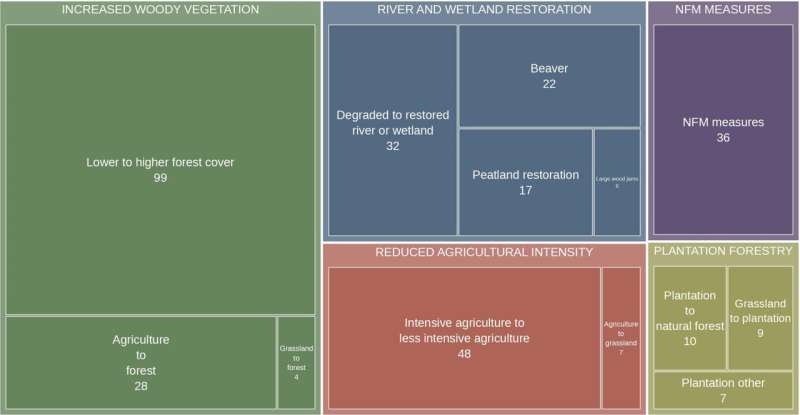New study highlights rewilding’s role in tackling flood and drought challenges
A comprehensive review of evidence led by researchers at Queen Mary University of London, in collaboration with the University of Sussex, Environment Agency, National Trust, Rewilding Britain, and Wildfowl and Wetlands Trust, has shed light on the potential of rewilding to enhance flood and drought resilience.
Rewilding is the large-scale restoration of ecosystems to the point where nature is allowed to take care of itself. It seeks to reinstate natural processes and, where appropriate, missing species, thereby enabling them to shape the landscape and habitats within.
The research synthesized outcomes from over 100 published studies, aiming to assess the efficacy of rewilding in mitigating floods and droughts.
Key findings from the study reveal that while research directly exploring the movement of water through rewilded landscapes remains sparse, assessing similar types of land cover change provides valuable indicators. The evidence suggests that rewilding could lead to reduced flood magnitudes, although the impacts on low-flow situations are more complex and warrant caution due to limited studies.
Professor Gemma Harvey, Professor of Physical Geography at Queen Mary University of London and one of the lead authors of “The role of rewilding in mitigating hydrological extremes: State of the evidence”, emphasized the importance of considering the combined influence of changing animal and plant communities on water movement in rewilded landscapes. She noted, “Rewilding drives multiple interacting ecosystem changes in the same location, and future research must account for this complexity.”
Furthermore, the research identified a notable gap in studying scrubland habitats, which are characteristic of natural vegetation regeneration in lowland temperate rewilding projects, therefore limiting the predictive capacity of existing studies in understanding hydrological responses.
The economic costs of floods and droughts are substantial, requiring significant government funding annually. Nature-based solutions, including rewilding, offer a promising avenue to address these challenges more cost-effectively while simultaneously enhancing biodiversity and providing social and cultural benefits to communities.
The study underscores the pressing need for ongoing monitoring and analysis of rewilding’s impact on water flows in river catchments, considering both floods and droughts. Such efforts are crucial for informed decision-making and effective implementation of rewilding initiatives to bolster flood and drought resilience.
The study is published in the journal WIREs Water.
More information:
Gemma L. Harvey et al, The role of rewilding in mitigating hydrological extremes: State of the evidence, WIREs Water (2024). DOI: 10.1002/wat2.1710
Citation:
New study highlights rewilding’s role in tackling flood and drought challenges (2024, February 26)
retrieved 26 February 2024
from https://phys.org/news/2024-02-highlights-rewilding-role-tackling-drought.html
This document is subject to copyright. Apart from any fair dealing for the purpose of private study or research, no
part may be reproduced without the written permission. The content is provided for information purposes only.

A comprehensive review of evidence led by researchers at Queen Mary University of London, in collaboration with the University of Sussex, Environment Agency, National Trust, Rewilding Britain, and Wildfowl and Wetlands Trust, has shed light on the potential of rewilding to enhance flood and drought resilience.
Rewilding is the large-scale restoration of ecosystems to the point where nature is allowed to take care of itself. It seeks to reinstate natural processes and, where appropriate, missing species, thereby enabling them to shape the landscape and habitats within.
The research synthesized outcomes from over 100 published studies, aiming to assess the efficacy of rewilding in mitigating floods and droughts.
Key findings from the study reveal that while research directly exploring the movement of water through rewilded landscapes remains sparse, assessing similar types of land cover change provides valuable indicators. The evidence suggests that rewilding could lead to reduced flood magnitudes, although the impacts on low-flow situations are more complex and warrant caution due to limited studies.
Professor Gemma Harvey, Professor of Physical Geography at Queen Mary University of London and one of the lead authors of “The role of rewilding in mitigating hydrological extremes: State of the evidence”, emphasized the importance of considering the combined influence of changing animal and plant communities on water movement in rewilded landscapes. She noted, “Rewilding drives multiple interacting ecosystem changes in the same location, and future research must account for this complexity.”
Furthermore, the research identified a notable gap in studying scrubland habitats, which are characteristic of natural vegetation regeneration in lowland temperate rewilding projects, therefore limiting the predictive capacity of existing studies in understanding hydrological responses.
The economic costs of floods and droughts are substantial, requiring significant government funding annually. Nature-based solutions, including rewilding, offer a promising avenue to address these challenges more cost-effectively while simultaneously enhancing biodiversity and providing social and cultural benefits to communities.
The study underscores the pressing need for ongoing monitoring and analysis of rewilding’s impact on water flows in river catchments, considering both floods and droughts. Such efforts are crucial for informed decision-making and effective implementation of rewilding initiatives to bolster flood and drought resilience.
The study is published in the journal WIREs Water.
More information:
Gemma L. Harvey et al, The role of rewilding in mitigating hydrological extremes: State of the evidence, WIREs Water (2024). DOI: 10.1002/wat2.1710
Citation:
New study highlights rewilding’s role in tackling flood and drought challenges (2024, February 26)
retrieved 26 February 2024
from https://phys.org/news/2024-02-highlights-rewilding-role-tackling-drought.html
This document is subject to copyright. Apart from any fair dealing for the purpose of private study or research, no
part may be reproduced without the written permission. The content is provided for information purposes only.
